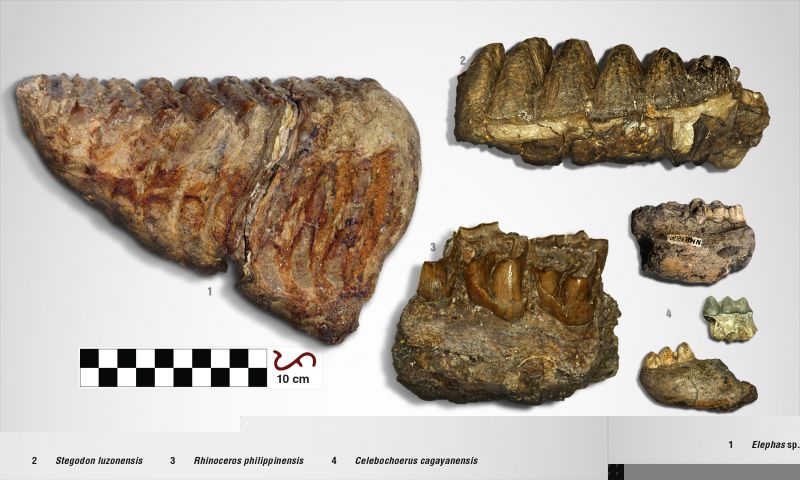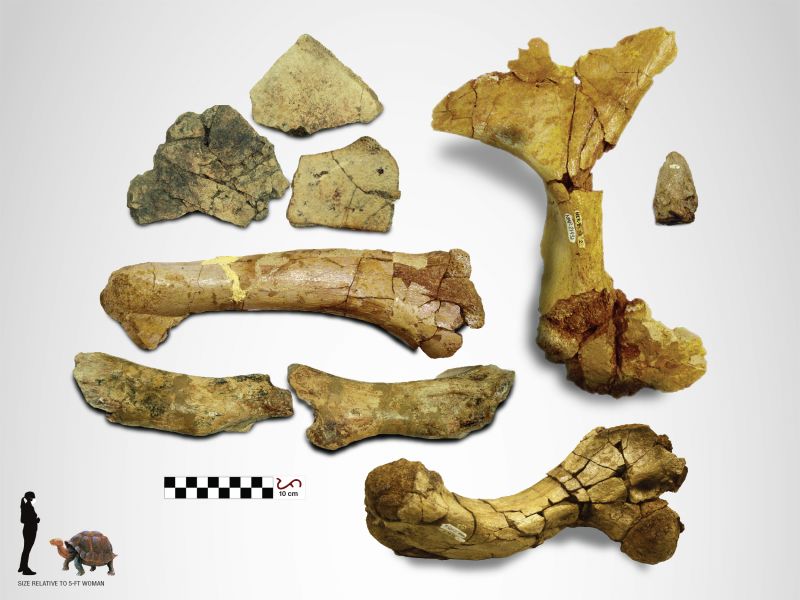Extinct Megafauna Fossils – Terrestrial
Large prehistoric animals used to roam around Philippine islands. A lot of these animals lived during the Pleistocene (0.0117 – 2.58 million years ago) but faced extinction towards the start of the Quaternary due to varying reasons.

Celebochoerus cagayanensis: These are teeth of an extinct species of pig found in Cagayan Valley. These suids are characterized by their extremely large upper tusks. Prior to the discovery of these specimens, the only record of the genus Celebochoerus are those from Sulawesi, Indonesia. These specimens were collected by the NM-GPD in 1971 in Liwan, Kalinga and in 1978 in Solana, Cagayan.
Stegodon luzonensis: Stegodons closely resemble elephants in appearance. The main difference can be seen through the comparison of their teeth. Stegodons are grazers and as such, will need low-crowned teeth. The tusks of stegodons are long and nearly straight. These tusks are so close to each other that there is no space for the trunk in between them. This forces the stegodons to rest its trunk sideways over one of the tusks. The Stegodon luzonensis was first described by von Koenisgwald in 1956 based on a right mandible with a broken molar.
Rhinoceros philippinensis: The first evidence of the presence of rhinoceros was a molar found in Laya, Cagayan in 1936. Identified as a new species, it was called Rhinoceros philippinensis. In 1965, another fossil rhino was found in Fort Bonifacio in Metro Manila. It was a portion of the right upper jaw with two well-preserved molars and one broken one was found. It was preserved under thick, compacted volcanic ash deposit of the Guadalupe Formation. The earliest rhinoceros in the world dates back to about 25 million years ago. This period is called the Miocene epoch. At present, they can be found only in some countries in Africa and Asia. In Asia, most are in India, Nepal and Indonesia.
Elephas sp: Remains of ancient elephants have been discovered in Cagayan Valley, Pangasinan, Rizal, and Iloilo. Most of them are molars, tusks, and bone fragments, belonging to large elephant species. Based on molar measurements, the size of these elephants is similar to that of the living Asian elephant (Elephas maximus), found today in India, Nepal, and some parts of Southeast Asia. These elephants differ from the African elephants (Loxodonta sp.) with respect to its anatomy. Asian elephants are significantly smaller, and their highest body point is in the head. Also, these elephants have much smaller ears and only the male species grow tusks.

Megalochelys sondaari: The Luzon giant tortoise (Megalochelys sondaari) inhabited Luzon during the Early Pleistocene (2.58 – 1.7 million years ago). The first fossils of this giant reptile were pieces of the carapace discovered at Espinosa Ranch, Liwan, Kalinga-Apayao (now Rizal, Kalinga) in 1971, and in San Juan, Tuao, Cagayan in 1976. Back then, its identity was still unknown. It was only in 1989 when several fossilized bones were discovered in Antipolo City, by Walter Schoell and Alyssa Peleo-Alampay of the National Institute of Geological Sciences (University of the Philippines-Diliman).
inquiry@nationalmuseum.gov.ph
(+632) 8298-1100
